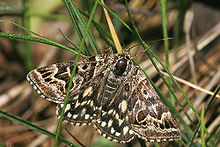Mother Shipton moth
| Mother Shipton moth | |
|---|---|
 |
|
 |
|
| Scientific classification | |
| Kingdom: | Animalia |
| Phylum: | Arthropoda |
| Class: | Insecta |
| Order: | Lepidoptera |
| Superfamily: | Noctuoidea |
| Family: | Erebidae |
| Genus: | Callistege |
| Species: | C. mi |
| Binomial name | |
|
Callistege mi (Clerck, 1759) |
|
| Synonyms | |
|
|
Callistege mi (Mother Shipton moth, ) is a moth of the family Erebidae. It was classified by Carl Alexander Clerck in 1759, and is also known under the name of Euclidia mi. In Finnish it is known as Piirtoyökkönen and in German as Scheck-Tageule. Its habitat spans over most of Europe, Siberia, the Russian Far East and Asia Minor. On the British Isles it is most common in England and Wales; less so in Scotland and Ireland. It flies by day, normally taking only short, rapid flights, and can be found in wasteland and other open habitats. The adult moth's forewing is 13 to 16 mm (0.51 to 0.63 inches) long, and the wingspan is 25 to 30 mm (0.98 to 1.18 inches). The stages of its life cycle are as follows: egg: May – September, larva: June – September, pupa: July – May, and imago: May – July. It hibernates as a pupa, and does so in a cocoon among blades of grass, or right underneath the ground. Among its foods is the nectar of the white clover and the creeping buttercup. The larva is yellowish with a dorsal line dark, finely pale in centre and with several fine wavy lines on each side. The spiracular line is broad, dark reddish brown, edged below with yellow or red.
The popular, English name for this moth comes from the pattern on its forewing. This pattern resembles the iconic representation of Ursula Southeil, known as Mother Shipton – a sixteenth-century prophetess and witch. Mother Shipton is a mostly mythical character, who supposedly foretold the death of Cardinal Wolsey in 1530. Charles Hindley, a nineteenth-century bookseller, created a prophetic poem that he claimed to be by Shipton. This poem told of "Carriages without horses" and air planes, as well as predicting the end of the world in 1881.
...
Wikipedia
